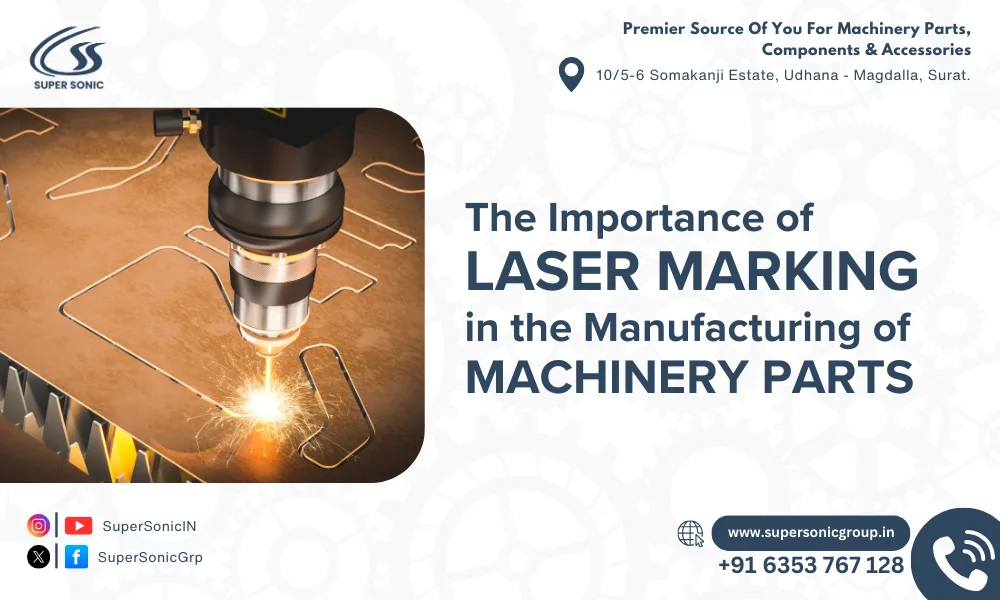In today’s highly competitive manufacturing landscape, the importance of precise and durable marking cannot be overstated. As industries continue to evolve, the need for effective identification and traceability of machinery parts has become paramount. One solution that stands out is laser marking technology. This blog will delve into the benefits of laser marking for machinery parts, the technology behind it, application areas, and tips for optimizing your laser marking processes for better efficiency and accuracy.
What is Laser Marking?
Laser marking is a non-contact manufacturing process that uses focused laser beams to engrave or mark materials. Unlike traditional marking methods such as ink printing or etching, laser marking provides a permanent and high-resolution mark that is resistant to wear and environmental factors.
Key Benefits of Laser Marking Machinery Parts
- Precision and Accuracy: Laser marking delivers exceptional accuracy, enabling manufacturers to create intricate designs, logos, barcodes, and serial numbers. The precision of laser marking significantly reduces the margin for error, ensuring that each part is marked correctly.
- Durability: Marks created by laser marking are resistant to corrosion, abrasion, and fading. This increased durability is essential for machinery parts exposed to harsh environments, ensuring the mark remains legible throughout the lifecycle of the equipment.
- Speed and Efficiency: Laser marking is a fast process that can significantly reduce downtime in production schedules. The technology allows for high-speed marking with minimal setup time, thus enhancing overall production efficiency.
- Environmental Benefits: Laser marking is a cleaner process compared to traditional marking methods. It does not require inks or solvents, which can be harmful to the environment. This eco-friendly approach aligns with the growing demand for sustainable manufacturing practices.
- Versatility: Laser marking can be used on various materials, including metals, plastics, ceramics, and even some composites. This versatility makes laser marking suitable for marking a wide range of machinery parts across different industries.
Applications in Machinery Manufacturing
Laser marking technology is utilized in various areas of machinery manufacturing, including:
- Automotive Industry: Used for marking components such as chassis parts, engine components, and identification tags.
- Aerospace: Essential for ensuring traceability and compliance with stringent regulations in manufacturing aircraft components.
- Electronics: Used for marking circuit boards, casings, and other electronic components for identification.
- Medical Devices: Ensures compliance with industry regulations by providing clear and durable markings on medical equipment.
Optimizing Your Laser Marking Process
To maximize the benefits of laser marking, consider the following tips:
- Material Selection: Choose the right laser type (fiber, CO2, or UV) based on the material of the part being marked. Each laser type works best on specific materials and thicknesses.
- Marking Parameters: Adjust speed, power, and frequency settings on your laser machine to customize the marking process. This fine-tuning helps achieve optimal results depending on the material and desired mark quality.
- Design Considerations: Create designs that are not only visually appealing but also practical for the marking process. Avoid intricate details that may not translate well onto certain materials.
- Regular Maintenance: Ensure that your laser marking equipment is regularly serviced and maintained. This practice helps to avoid unexpected downtimes and maintains the quality of markings.
- Test Runs: Prior to full production runs, conduct test markings on scrap materials. This allows you to fine-tune the settings and ensure that the output meets your quality standards.
Conclusion
Laser marking technology has proven to be an indispensable tool in the manufacturing of machinery parts. By providing precise, durable, and environmentally-friendly marks, laser marking enhances the quality and traceability of products. Manufacturers can significantly improve their production processes by adopting optimized laser marking techniques tailored to their specific applications. Embracing this technology not only meets industry standards but also paves the way for innovative and efficient manufacturing solutions in an ever-evolving market.
If you’re looking to implement or upgrade your laser marking processes in your manufacturing facility, consider consulting with a laser marking expert to explore the best solutions tailored to your specific needs. Embrace the future of manufacturing with laser marking technology and stay ahead of the competition.
